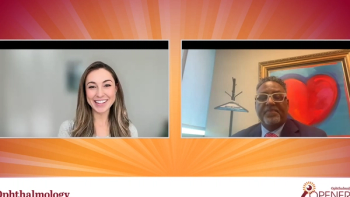
Redesigned pupil expansion device reduces cataract surgery risks
Pre-treatment with the femtosecond laser in eyes undergoing cataract surgery can induce miosis. The use of a pupil expansion device, however, offers an effective method for managing small pupils in femtosecond laser-assisted cases whether the problem pre-exists or is caused by the laser, said Boris Malyugin, MD, PhD.
Reviewed by Boris Malyugin, MD, PhD
Pre-treatment with the femtosecond laser in eyes undergoing cataract surgery can induce miosis. The use of a pupil expansion device, however, offers an effective method for managing small pupils in femtosecond laser-assisted cases whether the problem pre-exists or is caused by the laser, said Boris Malyugin, MD, PhD.
“Achieving and maintaining sufficient mydriasis is important to prevent complications during cataract surgery,” said Dr. Malyugin, professor of ophthalmology and deputy director, S. Fyodorov Eye Microsurgery Institution, Moscow. “Many ocular and systemic comorbidities affect pupil size, and we have learned that treatment with the femtosecond laser, which induces release of prostaglandins into the aqueous humor, is also a cause of intraoperative miosis.”
Miosis induced after femtosecond laser pre-treatment for cataract surgery was studied by Dr. Malyugin in a series of 47 eyes of 47 patients undergoing surgery for senile cataracts. The patients ranged in age from 57 to 76 years (mean 71.3 years) and had no ocular or systemic comorbidities.
A preoperative medication regimen for achieving and maintaining sufficient mydriasis was part of the surgical protocol, comprised of a topical NSAID (diclofenac sodium 0.1%) applied 3 times per day starting a day before surgery plus cyclopentolate 1% and phenylephrine 2.5% applied at 60, 45, and 30 minutes preoperatively.
The updated pupil expansion device is implanted through a 2.0-mm incision prior to FLACS. (Videos courtesy of Boris Malyugin, MD, PhD)
Pupil diameter measurements immediately before and 10 minutes after femtosecond laser treatment using a single system (LenSx Laser System, Alcon Laboratories) showed a statistically significant decrease (mean -1.56 ± 0.73 mm) from a mean of 7.79 ± 0.86 mm to 6.42 ± 1.16 mm. In 11 eyes (23.4%), the pupil diameter decreased to ≤ 6 mm and there was a decrease to ≤ 5 mm in 6 eyes (12.7%), he noted.
“Patient compliance with use of the NSAID before surgery was not checked,” he said.
Small pupil management
A small pupil presents a limitation to using the femtosecond laser in addition to increasing the risk of complications during cataract surgery.
Pupil expansion devices can be successful means to allow femtosecond laser pre-treatment in eyes with a small pupil or to manage miosis induced by the femtosecond laser.
A new version of a pupil expansion ring (Malyugin Ring 2.0, MicroSurgical Technology), can go through a smaller incision than the original device (Malyugin Ring, MicroSurgical Technology) and is more user- and iris-friendly, Dr. Malyugin said.
Implantation of the original expansion device following femtosecond laser capsulotomy and lens fragmentation. (Videos courtesy of Boris Malyugin, MD, PhD)
The new model is available in 6.25 mm and and 7.0 mm and is made of smaller-gauge material than the original (5-0 polypropylene versus 4-0 polypropylene). This makes it thinner and more flexible. The injector was also redesigned and is much more slim in order to easily pass through an incision of only 2.0 mm, Dr. Malyugin said.
The pupil expander provides eight points of fixation, but is more gentle to the pupil edge and sphincter because it exerts less compression force. Yet, the device provides the same performance for maintaining the enlarged circular pupil, even if the surgeon uses aggressive phacoemulsification settings.
“There is no need to change the surgical technique with the new generation device,” Dr. Malyugin said. “Insertion and removal are easy using the injector, and after the device is removed, the pupil spontaneously returns to a nice, round configuration.”
Boris Malyugin, MD, PhD
This article was adapted from Dr. Malyugin’s presentation at the 2016 meeting of the American Society of Cataract and Refractive Surgery.
Dr. Malyugin holds a patent on the Malyugin Ring/Malyugin Ring 2.0. Dr. Malyugin is a consultant and receives travel grants from Alcon Laboratories.
Newsletter
Don’t miss out—get Ophthalmology Times updates on the latest clinical advancements and expert interviews, straight to your inbox.



















































.png)


